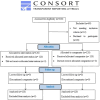Clinical performance of polyethylenefiber reinforced resin composite restorations in endodontically treated teeth: (a randomized controlled clinical trial)
- PMID: 39448991
- PMCID: PMC11515345
- DOI: 10.1186/s12903-024-05009-8
Clinical performance of polyethylenefiber reinforced resin composite restorations in endodontically treated teeth: (a randomized controlled clinical trial)
Abstract
Aim: The purpose of this study was to evaluate the performance of polyethylene fiber reinforced resin composite fillings compared to bulk fill resin composite fillings in endodontically treated teeth over a two-year monitoring period.
Method: A total of 240 individuals with endodontically treated lower molars and a moderate amount of tooth structure were divided into two equal groups of 120 each. One group received polyethylene fiber reinforced bulk fill resin composite restorations while the other group received only bulk fill resin composite restorations, both applied as per manufacturer guidelines. Two proficient experienced blinded assessors assessed the restorations using modified USPHS criteria at baseline, 6, 12, and 24 months.
Statistical analysis used: Data analysis involved the utilization of Mann-Whitney U, Friedman's test, and Nemenyi post hoc test, with age data being displayed as mean and standard deviation. The significance level was established as p < 0.05, and R software was utilized for statistical analysis.
Results: There were no notable distinctions in any parameters or scores between the intervention and comparator groups at various time points. Alpha scores were present for retention, gross fracture, and secondary caries at all follow up intervals.
Conclusion: Both direct resin composite restorations reinforced with polyethylene fibers and direct bulk fill resin composite restorations placed in endodontically treated molars with moderate remaining tooth structure demonstrated satisfactory clinical outcomes during a 24-month follow-up period.
Clinical relevance: Bulk fill resin composites directly placed in endodontically treated molars with moderate remaining tooth structure showed promise as a treatment option over a two-year period.
Clinical trial registration: (06-01-2022) on https://ClinicalTrials.gov with the ID (NCT05180903).
Keywords: Bulk fill composite; Class II cavities; Clinical trial that is controlled and randomized; Fiber reinforced composite; Polyethylene fibers; Ribbond; Teeth that have undergone endodontic treatment.
© 2024. The Author(s).
Conflict of interest statement
The authors declare no competing interests.
Figures




References
-
- Selvaraj H, Krithikadatta J, Shrivastava D, Onazi MA, Algarni HA, Munaga S, Hamza MO, saad Al-fridy T, Teja KV, Janani K, Alam MK. Systematic review fracture resistance of endodontically treated posterior teeth restored with fiber reinforced composites-a systematic review. BMC Oral Health. 2023;23(1):566. - PMC - PubMed
-
- Ray HA, Trope M. Periapical status of endodontically treated teeth in relation to the technical quality of the root filling and the coronal restoration. Int Endod J. 1995;28(1):12–8. - PubMed
-
- Garoushi S, Gargoum A, Vallittu PK, Lassila L. Short fiber-reinforced composite restorations: a review of the current literature. J Invest Clin Dent. 2018;9(3):e12330. - PubMed
Publication types
MeSH terms
Substances
Associated data
LinkOut - more resources
Full Text Sources
Medical

